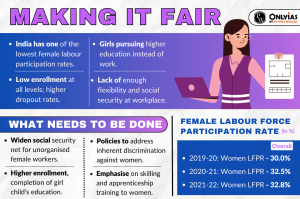Context:
- This article is based on an Editorial “What’s the saas got to do with it” which was published in the Times of India. Over the last two decades, India has experienced significant economic growth, marked by a shift from agriculture to other sectors. However, challenges persist, including slow formal job creation and a lack of significant growth in the manufacturing sector.
| Relevancy for Prelims: Women participation in workforce, India GDP Growth Rate, and Indian Manufacturing Sector.
Relevancy for Mains: Indian Manufacturing Sector, Economic Development, Indian Economy associated challenges and Challenges faced by the women workforce, Gender discriminition, and special emphasis on women participation in workforce. |
Women Participation in Workforce
- Shift in Employment: Millions have shifted from agriculture, leading to a rise in salaried workers while casual labor has decreased.
- Example: A decrease in the proportion of agricultural workers and an increase in salaried positions.
- Slow Formal Job Creation
- Lagging Behind: Formal job creation lags behind informal employment opportunities.
- Example: Construction and informal services are the primary job creators, not formal sectors like manufacturing.

- Macro Level Challenges
- Weak Correlation: Weak correlation between non-farm GDP growth and non-farm employment growth since the 1990s.
- Example: Policies promoting faster GDP growth don’t necessarily translate to faster job creation.
- Gender Discrimination: Women participation in workforce
- Persistent Earnings Gap: Gender-based earnings gaps persist even after considering education and work type.
- Example: Women face discrimination in earnings that can’t be solely explained by differences in education or job type.
- Role of Social Norms- Women participation in Workforce
- Impact on Women’s Work: Norms impact whether women work, considering factors like husband’s income and family opinions.
- Example: Economic growth led to a decline in women’s employment due to traditional norms.
Also read: Role Of Women And Women’s Organization
Women participation in workforce: Challenges
- Disproportionate Burden of housework, lack of public transport, unsafe working conditions, and mobility restrictions.
- Example: Women face challenges in balancing housework and work due to societal norms.
The Path Ahead
- It’s high time for India to take appropriate steps to generate formal jobs and achieve significant growth in the manufacturing sector, while making more focus on women by taking appropriate actions to counter challenges faced by them.
- There is a need to generate awareness among masses about their individual skills and impact on the growth of India, rather than old age thinking of allowing women to participate in the formal workforce only for just survival and economic needs.
Conclusion
Addressing the multifaceted challenges of women participation in workforce is crucial for India’s sustainable development. Fostering formal job creation, dismantling gender discrimination in earnings, and challenging ingrained social norms are imperative steps.
| Attempt the PY Prelims Question:
Which of the following gives ‘Global Gender Gap Index’ ranking to the countries of the world? (2017)
- World Economic Forum
- UN Human Rights Council
- UN Women
- World Health Organization
Ans: A |
![]() 4 Oct 2023
4 Oct 2023
